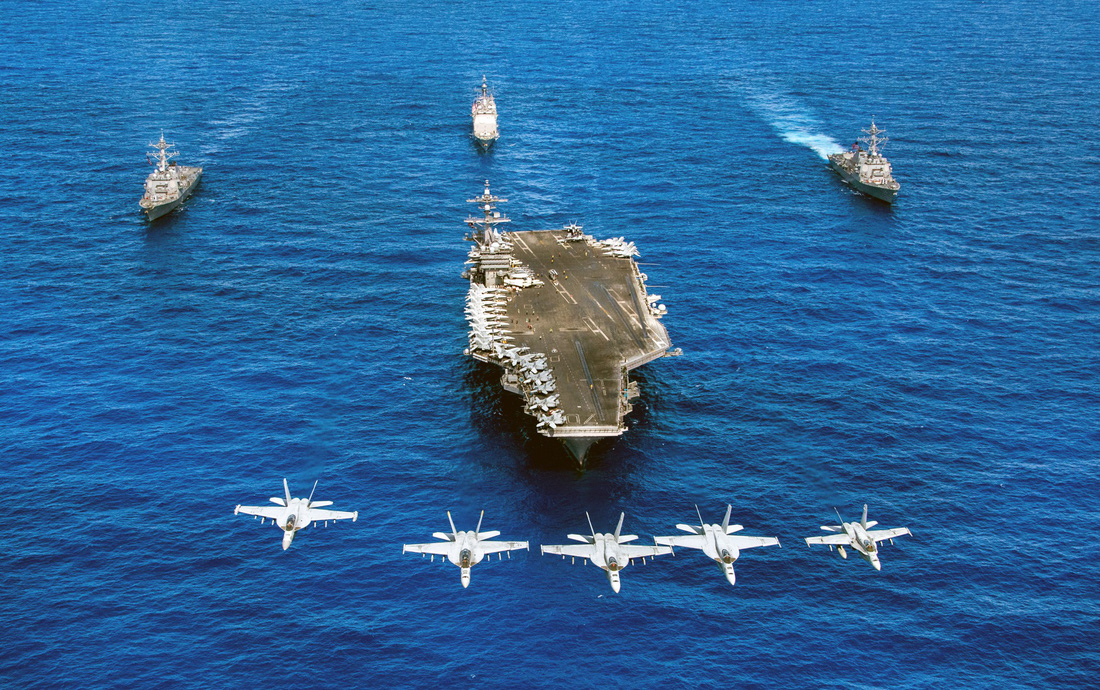Nuclear-powered aircraft carrier USS Carl Vinson, the flagship of the U.S. Navy Carrier Strike Group One (CSG-1), is scheduled to dock in Vietnam from March 5 to 9, accompanied by the guided missile cruiser USS Lake Champlain and the destroyer USS Wayne E. Meyer.
As no U.S. aircraft carrier has ever docked at a Vietnamese port since the war ended in 1975, international media is referring to the upcoming visit as the largest military presence by the U.S. in Vietnam since that time.
The Da Nang visit was announced in January, when U.S. Secretary of Defense James Mattis visited Hanoi, his first trip to Vietnam since assuming his post.
During a meeting with his Vietnamese counterpart General Ngo Xuan Lich, both ministers agreed to request approval for the visit from their superiors.
On February 21, Vietnamese Ambassador to the United States Pham Quang Vinh toured the USS George H.W. Bush aircraft carrier during a business trip to Norfolk, Virginia.
Launched in 1980, USS Carl Vinson uses the call sign “Gold Eagle.” The ship is named after Carl Vinson, a Congressman from Georgia, in honor of his contributions to the U.S. Navy. In 2011, the body of Osama bin Laden was buried at sea from the ship’s deck.
CSG-1 was patrolling off the Philippines prior to heading for the East Vietnam Sea in preparation for the visit.
Below are some photos of the three main ships in the Vietnam visit.
 |
| USS Lake Champlain is a Ticonderoga-class guided missile cruiser. Photo: U.S. Navy |
 |
| The USS Lake Champlain is named in honor of the Battle of Lake Champlain, which took place during the War of 1812. Photo: U.S. Navy |
 |
| RGM-84 Harpoon missiles on board the USS Lake Champlain. Photo: AP |
 |
| The USS Lake Champlain is capable of launching a range of missiles including Tomahawks, SM-2, SM-3s, and RIM-162 ESSMs. Photo: U.S. Navy |
 |
| USS Lake Champlain has been to the Persian Gulf on multiple occasions, first as a part of Operation Desert Shield, then following Operation Desert Storm. Photo: U.S. Navy |
 |
| The USS Carl Vinson cost US$3.8 billion, carrying some 72 aircraft including FA18 Super Hornets and Hornets, EA 18G Growlers, Nighthawk helicopters and surveillance aircraft. Photo: U.S. Navy |
 |
| Aircraft aboard the USS Carl Vinson. Photo: AP |
 |
| USS Carl Vinson is equipped with such armaments as Multiple NATO Sea Sparrow, Phalanx CIWS, and Rolling Airframe Missile mounts. Photo: U.S. Navy |
 |
| With a crew of more than 5,800, the USS Carl Vinson is well equipped with medical amenities. Photo: U.S. Navy |
 |
| USS Carl Vinson crew members load missiles onto the aircraft carrier. Photo: U.S. Navy |
 |
| Two F-18 Hornets launch from the USS Carl Vinson. Photo: U.S. Navy |
 |
| USS Carl Vinson receives replenishment from a helicopter. Photo: U.S. Navy |
 |
| USS Carl Vinson captain Douglas Verissimo has hailed his ship as a ‘floating city’. Photo: U.S. Navy |
 |
| The USS Carl Vinson (CVN-70) participates in a drill with Japanese destroyers. Photo: Reuters |
 |
| Launched in October 2008, the guided missile destroyer USS Wayne E. Meyer is one of the U.S. Navy’s newest warships. Photo: U.S. Navy |
 |
| The USS Wayne E. Meyer is named after Rear Admiral Wayne E. Meyer, known as the "Father of Aegis." Photo: U.S. Navy |
 |
| USS Wayne E. Meyer carries the 100th AEGIS Weapon System to be put into operation by the U.S. Navy. Photo: U.S. Navy |
 |
| Armaments on the USS Wayne E. Meyer include Mk 41 vertical launch systems. Photo: U.S. Navy |
 |
| The USS Wayne E. Meyer can carry up to two SH-60 Seahawk helicopters. Photo: U.S. Navy |
Like us on Facebook or follow us on Twitter to get the latest news about Vietnam!














































